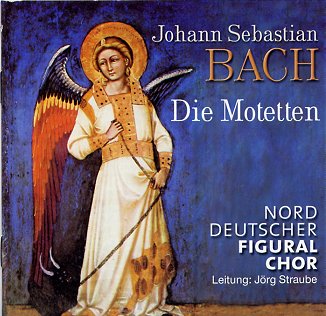Bach’s great motets are one aspect of the master’s
work that is possibly the most underestimated. You may well already
have a favourite recording from amongst the many that exist. I
love a version by the Chamber Choir of Augsburger Domsingknaben,
(the Augsburg Cathedral Choirboys). These are an all-male group
directed by Reinhard Kammler (on Deutsche Harmonia Mundi RD 77031).
You may well have one of the other eight versions available but
this one is different> For a start it spreads out over a double
CD set. It puts the motets into the context of similar pieces
by Bach himself and by his contemporaries and members of his own
family past and future. It’s a format which provokes thought and
highlights some fine and unknown works. It also allows one to
realize the greatness of these motets. They stand out from the
rest like an illuminated capital letter at the head of an ancient
manuscript. The motets are evenly distributed across the two discs.
If you did want to play them right through, you would encounter
a programme of interest and contrast.
The motets were first performed in Leipzig. Their
place in the service was generally immediately after the introductory
organ prelude at the start of the service. When commentators write
that Bach was the last of the medieval composers they may well
be thinking of the motet form and its total reliance on polyphony,
in Bach’s case, on fugue. Although each is based on a chorale
melody each has at least one fugal movement.
Bach remarked in a memorandum in August 1730
that he expected about four or five to a part. Instrumental participation
was acceptable, indeed even necessary to help tuning and add strength.
Most recordings opt for continuo of some sort. I was involved
in one performance some twenty years ago now, completely a
capella. This new recording opts for a strong contingent of
strings and continuo. As the booklet notes by Peter Wolliny, logically
explain, "the vocal parts can also be replaced or reinforced
by all kinds of instruments, this is confirmed by the instrumental
material Bach used to perform his own motets".
The notes divide the music up neatly into four
distinct groups. These first set about describing the six motets
and secondly the other six (shorter) motets by Bach, which are
not part of the set. These are described as ‘stylistically related
works’. Thirdly come pieces from Bach’s library. This accounts
for one by Knupfer, and finally the apocryphal motets once attributed
to J.S. These include the ones by Telemann which frame a brief
motet by Bach himself.
Amongst the intriguing and little known works
explored by composers new to me is a fine motet based on the well
known hymn ‘Nun Danket alle Gott’. This is by Bach’s son-in-law
Johann Christophe Altnikol. In this the hymn only makes its presence
fully felt at the end of the work’s compact six minutes. Similarly,
Johann Wagner a pupil of J.S., is another, whose motet "Lob
und Herr und Weisheit" starts off with a delightful folk-like
melody then falls quickly into a rather learned fugue before ending
with the chorale itself. Sebastian Knupfer, who became the Thomaskantor
in 1657, is represented by a fine and solemn motet " Erforsche
mich, Gott". This is in a homophonic style not dissimilar
to early Schütz. So the music on this CD spans more than
a century.
Incidentally to hear Knupfer’s music performed
by a small group with a significant instrumental accompaniment
look out for Cantus Cöln on a marvellous disc ‘The Thomaskirk
before Bach’ (Deutsche Harmonia Mundi 05472 77203 2).
I have to say at this point that despite the
above-mentioned strengths and the interest these performances
offer, I am not too impressed with the interpretation and final
result.
A list of the performers is given in the accompanying
booklet, and one can count for example seventeen sopranos and
eleven female altos. The choral sound is often beautiful, especially
emphasising a legato effect. Sadly these performances lack a certain
vitality. In ‘Jesu Mein Freude’, surely the highlight of the set,
the result is mostly too slow, rather flabby and middle-aged.
I feel the same about ‘Furchte dich nicht’. Surely the choir is
too large for this music and not what Bach had in mind. Also disappointing
is the fact that the double choir spacing needed for ‘Komm, Jesu,
Komm’ and for another eight-part motet ‘Der Geist hilft unser’
is not strongly characterised. This is partly the fault of the
recording, which could surely have helped. Equally however the
conductor should have insisted on bringing across this significant
feature.
The booklet essay is well translated both into
French and English and is certainly valuable. The texts however,
some of which are a little obscure, are not translated. This is
disappointing.
My advice is that if you want a recording which
puts these motets into their period context then this set might
be enjoyable and fascinating. If you only want the Motets, then
look elsewhere for performances which have that indefinably special
something about them.
For an intimate recording using size of ensemble
Bach probably had in mind you could try the Scholars Baroque Ensemble
on Naxos (8.553823) or the version for male voices I mentioned
above.
Gary Higginson
